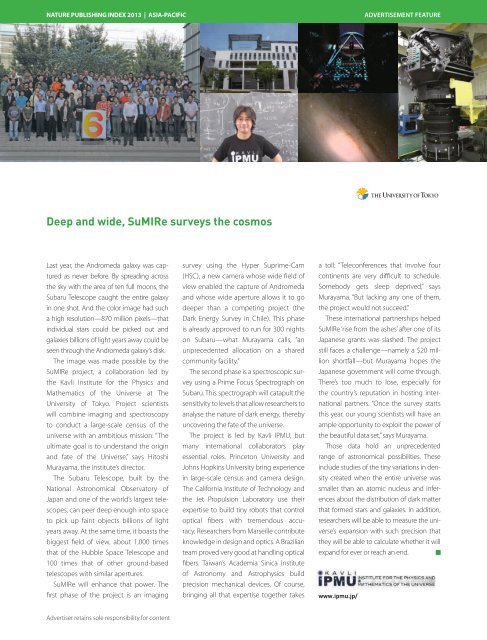NPI2013_Asia-Pacific
NPI2013_Asia-Pacific
NPI2013_Asia-Pacific
Create successful ePaper yourself
Turn your PDF publications into a flip-book with our unique Google optimized e-Paper software.
NATURE PUBLISHING INDEX 2013 | ASIA-PACIFICADVERTISEMENT FEATUREDeep and wide, SuMIRe surveys the cosmosLast year, the Andromeda galaxy was capturedas never before. By spreading acrossthe sky with the area of ten full moons, theSubaru Telescope caught the entire galaxyin one shot. And the color image had sucha high resolution—870 million pixels—thatindividual stars could be picked out andgalaxies billions of light years away could beseen through the Andromeda galaxy’s disk.The image was made possible by theSuMIRe project, a collaboration led bythe Kavli Institute for the Physics andMathematics of the Universe at TheUniversity of Tokyo. Project scientistswill combine imaging and spectroscopyto conduct a large-scale census of theuniverse with an ambitious mission: “Theultimate goal is to understand the originand fate of the Universe,” says HitoshiMurayama, the institute’s director.The Subaru Telescope, built by theNational Astronomical Observatory ofJapan and one of the world’s largest telescopes,can peer deep enough into spaceto pick up faint objects billions of lightyears away. At the same time, it boasts thebiggest field of view, about 1,000 timesthat of the Hubble Space Telescope and100 times that of other ground-basedtelescopes with similar apertures.SuMIRe will enhance that power. Thefirst phase of the project is an imagingsurvey using the Hyper Suprime-Cam(HSC), a new camera whose wide field ofview enabled the capture of Andromedaand whose wide aperture allows it to godeeper than a competing project (theDark Energy Survey in Chile). This phaseis already approved to run for 300 nightson Subaru—what Murayama calls, “anunprecedented allocation on a sharedcommunity facility.”The second phase is a spectroscopic surveyusing a Prime Focus Spectrograph onSubaru. This spectrograph will catapult thesensitivity to levels that allow researchers toanalyse the nature of dark energy, therebyuncovering the fate of the universe.The project is led by Kavli IPMU, butmany international collaborators playessential roles. Princeton University andJohns Hopkins University bring experiencein large-scale census and camera design.The California Institute of Technology andthe Jet Propulsion Laboratory use theirexpertise to build tiny robots that controloptical fibers with tremendous accuracy.Researchers from Marseille contributeknowledge in design and optics. A Brazilianteam proved very good at handling opticalfibers. Taiwan’s Academia Sinica Instituteof Astronomy and Astrophysics buildprecision mechanical devices. Of course,bringing all that expertise together takesa toll: “Teleconferences that involve fourcontinents are very difficult to schedule.Somebody gets sleep deprived,” saysMurayama. “But lacking any one of them,the project would not succeed.”These international partnerships helpedSuMIRe ‘rise from the ashes’ after one of itsJapanese grants was slashed. The projectstill faces a challenge—namely a $20 millionshortfall—but Murayama hopes theJapanese government will come through.There’s too much to lose, especially forthe country’s reputation in hosting internationalpartners. “Once the survey startsthis year, our young scientists will have anample opportunity to exploit the power ofthe beautiful data set,” says Murayama.Those data hold an unprecedentedrange of astronomical possibilities. Theseinclude studies of the tiny variations in densitycreated when the entire universe wassmaller than an atomic nucleus and inferencesabout the distribution of dark matterthat formed stars and galaxies. In addition,researchers will be able to measure the universe’sexpansion with such precision thatthey will be able to calculate whether it willexpand for ever or reach an end.www.ipmu.jp/Advertiser retains sole responsibility for content


